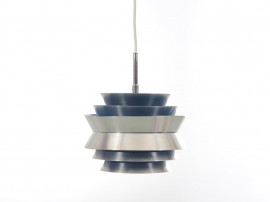Carl Thore
Sigurd 'Carl Thore' Lindkvist was born in 1916 in Åmål, Sweden. Lindkvist worked for the lighting firm Luko, before joining Granhaga Metallindustri AB in 1961 as Head of Sales and Lighting Design. Lindkvist apparently adopted the pseudonym Carl Thore when he was presenting his lights to a client. Not wanting to reveal to the customer his identity as a designer, Lindkvist used his two middle names instead. The lights were labeled ‘Carl Thore Design’ from then on. Lindkvist remained with the company until he retired in 1981.
In the postwar era, Scandinavian designer-architects explored new ways in which they could defuse and redirect light. Lindkvist falls into the category of designers producing minimalist, sculptured Space Age table lamps, wall lights, and pendants, especially in copper, aluminum, brightly-colored glass, and plastic. In fact, much like Poul Henningsen’s PH Lamp Series (from 1925) for Louis Poulsen, Lindkvist created a series of layered shades—known officially as concentric parabolic-section cowls—to spread the light while concealing the lightbulb for his appropriately named Trava Lamp (1960s), meaning 'Stack' in English. This glare-free approach was perfect for the reduction of the harsh, glaring bulbs available at the time of production.
Today, the Trava Lamp is the most popular and widely distributed of Lindkvist’s Carl Thore lamp designs, as well as his best-known design today. The lamp appears in many guises, as it was produced with several variations of style, size, and color. It was mainly sold in Sweden through the Swedish Consumer Cooperative chain of shops known as KF Interior, but it was also exported to Denmark, the UK, the Netherlands, and even as far as South Africa.
Recently, the production of Carl Thore Design has often been misattributed to the Danish modern lighting manufacturing company Fog & Mørup. This is most likely because Lindkvist’s designs clearly reference Fog & Mørup’s head designer Jo Hammerborg’s (1920-1982) Nova Pendant Light (1963).
Lindkvist’s date of death is unknown, as are the details of his other designs for Granhaga.
source : pamono



